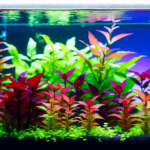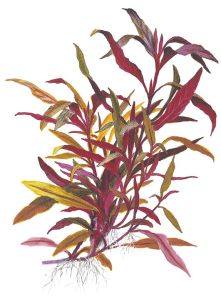Alternanthera Reineckii Care: Essential Tips for Amazing Aquarium Plants
Wondering how to best care for Alternanthera Reineckii to achieve that vibrant red in your aquarium? This no-nonsense guide delivers key insights into the right water parameters, lighting, fertilization, and more, ensuring your success in nurturing this stunning plant. Without overwhelming complexity, we deliver the essentials – prepare for a dive into straightforward advice that ensures lush growth and mitigates common problems, letting your Alternanthera Reineckii make a bold statement in your aquascape.
Table of Contents
Key Takeaways
- Alternanthera Reineckii, originating from South America, offers aquarium enthusiasts a variety of forms, such as the popular ‘Mini’ and ‘Rosanervig’, differing in size, color, and ideal placement within an aquarium.
- Successful growth of Alternanthera Reineckii requires careful consideration of tank conditions including tank size, water parameters, powerful lighting exceeding 40 PAR, and a nutrient-rich substrate to support its vibrant coloration and healthy development.
- Alternanthera Reineckii benefits from CO2 supplementation and a balanced fertilization regime to aid in robust growth and maintain its red pigmentation, but the plant is sensitive to conditions such as high CO2 levels and certain water parameters which can lead to issues like melting and chlorosis.
Understanding Alternanthera Reineckii: Origins and Varieties
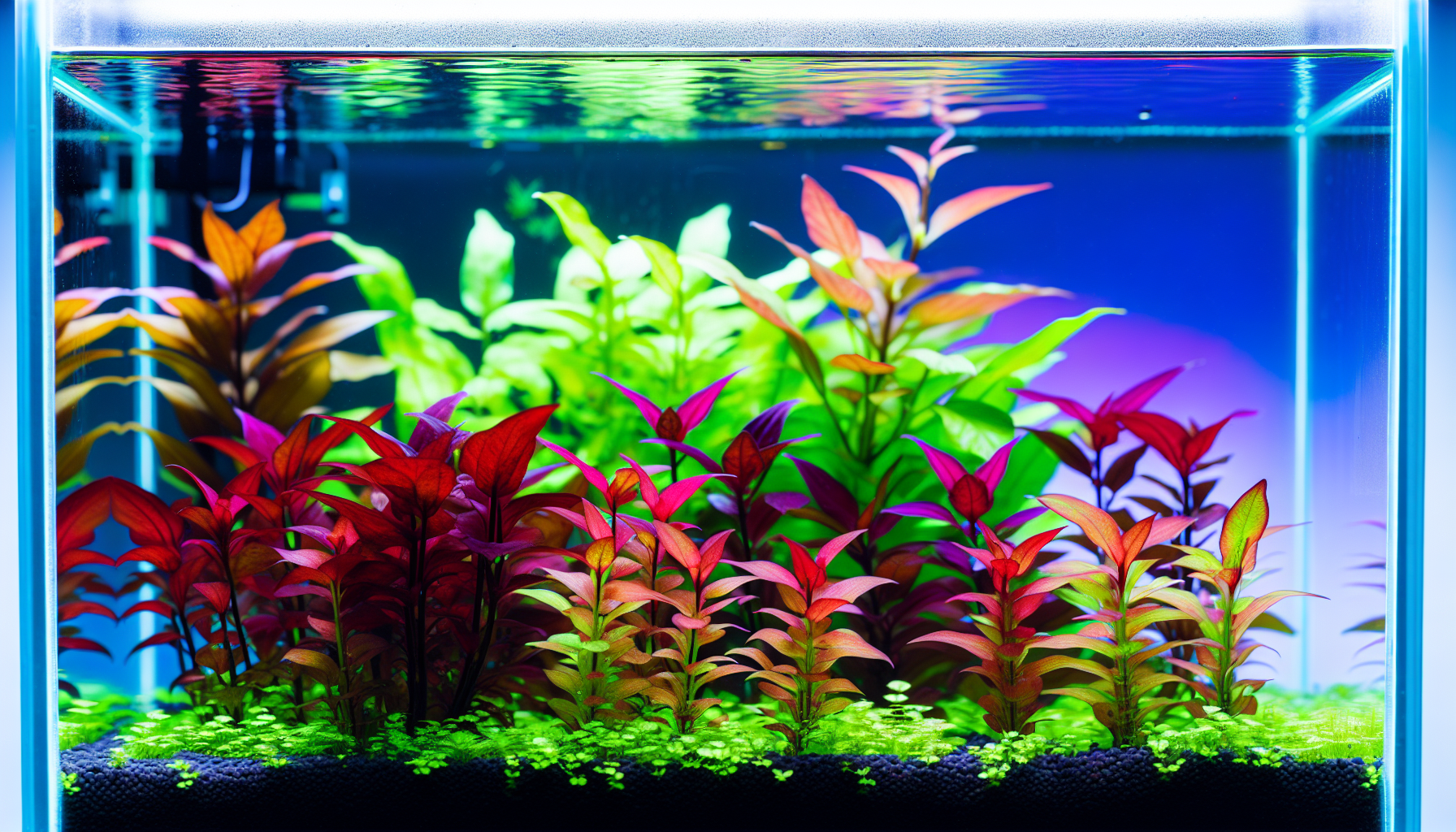
Alternanthera Reineckii is a beautiful addition to any aquarium, thanks to its vibrant colors and diverse variations. Originating from South America, this plant is commonly found along riversides, especially in areas that are periodically flooded during the rainy season. It’s known by several names including Red Mint and Alternanthera rosaefolia, with various forms and variations that are popular among aquarium enthusiasts.
We will now explore its natural habitat, delve into popular varieties, and highlight the distinctive differences between these varieties.
Natural Habitat and Distribution
Alternanthera Reineckii is a true South American gem, with a range extending from Bolivia to Brazil and Northern Argentina. In its natural habitat, this plant thrives in clear water creeks characterized by high transparency and low levels of sediment. Interestingly, Alternanthera Reineckii exhibits a unique characteristic of occurring in both semi-terrestrial and aquatic forms in the wild, depending on the specific environmental conditions.
This adaptability, coupled with its stunning overall appearance, contributes to its worldwide popularity among aquarium enthusiasts.
Popular Varieties and Trade Names
Alternanthera Reineckii comes in several varieties, each with its own distinct appeal. It’s popularly known in the aquarium trade as the Scarlet Temple. Other common names include:
- Reineckia
- Ruby Red
- Red Mint
- Alternanthera rosaefolia
- AR for short.
A particular favorite among aquascapers is Alternanthera Reineckii ‘mini’, adored for its shorter stature, intense red color, and suitability for foreground or midground placement. With such a rich variety to choose from, there’s an Alternanthera Reineckii for every aquarium design.
Differences Between Varieties
While all Alternanthera Reineckii varieties share a common lineage, their differences are what make them truly special. The ‘Rosanervig’ variety, for instance, is celebrated for its vibrant pink leaves and slightly smaller size with lightly colored veins, in contrast to the standard types. The pink underside of Alternanthera Reineckii offers a strong visual contrast, particularly when grouped together in the aquarium.
The ‘Mini’ variant is a favorite among Dutch aquascapes for its miniature growth and bright red coloration. It can grow to an approximate height of 8 inches and can be used as a foreground, midground, or background plant in an aquarium layout. In contrast, taller varieties like ‘rosaefolia’ are typically used in the background to establish depth and provide a layered visual effect. These distinctive differences make Alternanthera Reineckii a versatile choice for any aquarium setup.
Ideal Tank Conditions for Alternanthera Reineckii

For Alternanthera Reineckii to truly flourish, the right tank conditions are key. This includes considering tank size, water parameters, lighting, and substrate.
We will now examine what each of these aspects involves and their contribution to the plant’s vibrancy and growth.
Tank Size and Setup
The preferred tank size for Alternanthera Reineckii depends on the plant variation. The ‘mini’ forms are suitable for small nano tanks, while other varieties require at least 10 gallons (40 liters). But this plant doesn’t just add beauty to your tank. Its dense foliage and tunnel-like structures offer practical benefits too, serving as a hiding spot and providing shade for small aquarium inhabitants.
Whether you’re setting up a small planted aquarium or a large one, there’s an Alternanthera Reineckii that will fit perfectly into your design.
Water Parameters
When it comes to water parameters, Alternanthera Reineckii prefers:
- Slightly acidic water with a pH range between 6.0 and 7.0
- Water temperature between 68 and 80.6 degrees Fahrenheit (22 to 27 degrees Celsius) to promote healthy growth, and never falling below 68 degrees Fahrenheit (22 degrees Celsius)
- Soft to moderately hard water conditions, with a hardness range of 6 to 12 dGH
Maintaining the right water parameters can keep your Alternanthera Reineckii in prime condition.
Lighting Requirements
One of the key factors influencing the vibrant red coloration of Alternanthera Reineckii is lighting. This plant requires powerful illumination exceeding 40 PAR to maintain its signature coloration and optimal growth. It prefers medium to high light intensities, generally in the range of 0.4 to 1 watt per liter. Utilizing a full spectrum light source that includes red and blue wavelengths significantly enhances the red pigmentation of Alternanthera Reineckii. While it can tolerate moderate lighting, insufficient light levels can result in the plant losing its bright color over time.
Adequate lighting not only contributes to the coloration of Alternanthera Reineckii, but also promotes denser and healthier leaf growth. An ideal photoperiod to maintain Alternanthera Reineckii’s vibrancy is typically between 8 to 10 hours per day. Finnex Planted Plus Lights are recommend by us here at The Shrimp Farm
Substrate Selection
The right substrate can make all the difference in the growth of your Alternanthera Reineckii. Nutrient-rich substrates are highly recommended, as they lead to more consistent growth rates and fewer aerial roots. While Alternanthera Reineckii can tolerate slower growth rates due to their less demanding nutrient needs, stability in substrate nutrients is crucial for consistent development.
Ensuring that the substrate is free from toxic conditions like hydrogen sulfide buildup is important to prevent stem rot and promote healthy rooting. By providing a nutrient-rich substrate, Alternanthera Reineckii can absorb nutrients from both the water and the substrate, allowing the plant to prevent chlorosis and maintain overall health. We recommend UNS Controsoil which we also sell!
CO2 and Fertilization: Key to Vibrant Growth
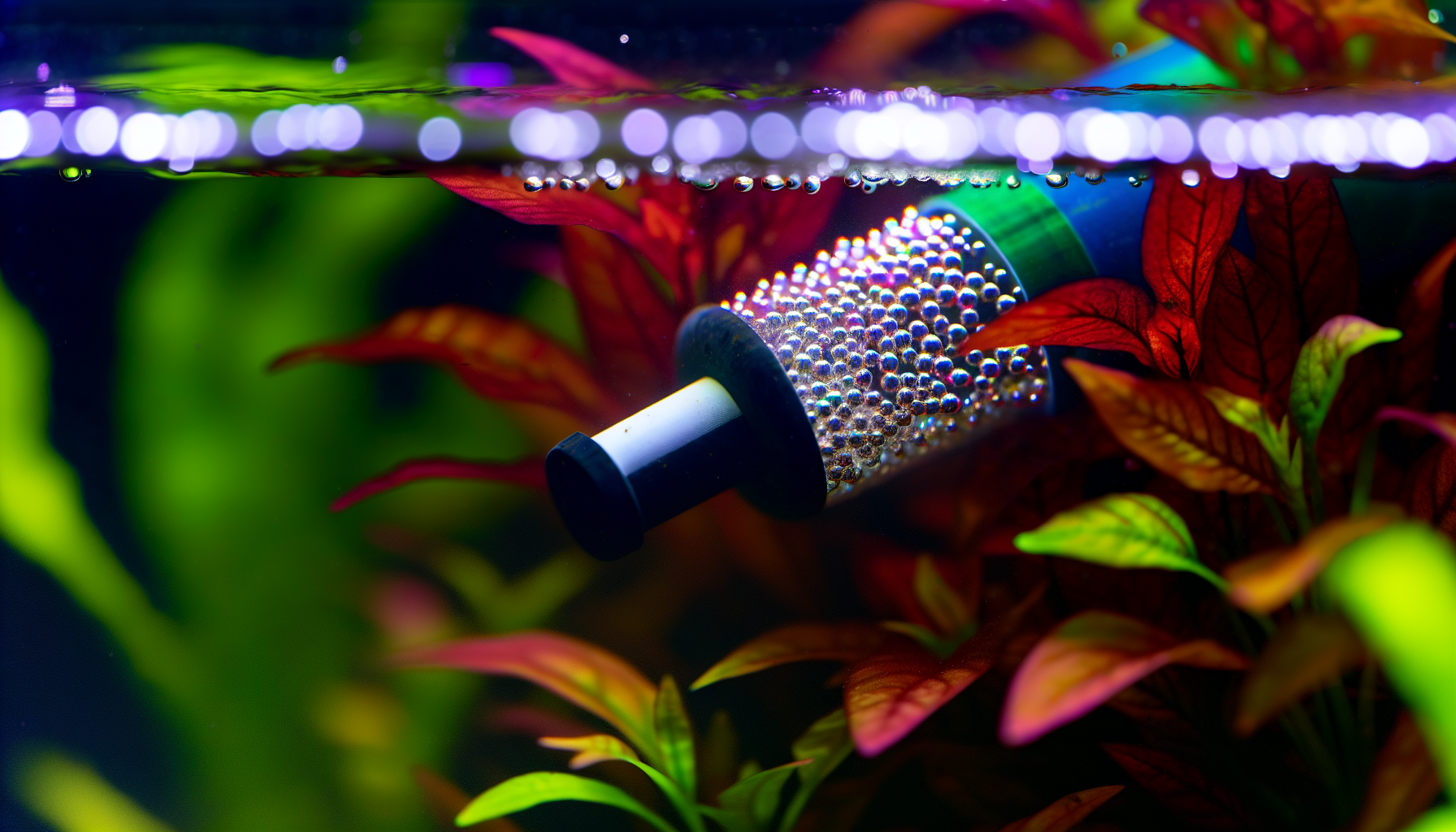
The vibrant growth of Alternanthera Reineckii is significantly enhanced by CO2 supplementation and the right fertilization. These elements play a crucial role in its growth speed and red coloration.
We will now examine the specifics of CO2 supplementation, essential nutrients, and how to balance nutrient levels.
CO2 Supplementation
CO2 supplementation plays a vital role in the growth and coloration of Alternanthera Reineckii. It enhances the robust growth and red or pink coloration of the plant’s leaves. The optimal CO2 concentration for Alternanthera Reineckii in an aquarium is 20-30 mg/L to promote the best growth and coloration.
Hence, medium to high light intensity and added CO2 greatly improve the overall growth, health, and appearance of Alternanthera Reineckii and Alternanthera Reineckii ‘Mini’.
Here at The Shrimp Farm we sell Co2 canisters and co2 regulators for your planted aquarium!
Essential Nutrients and Fertilizers
For Alternanthera Reineckii to thrive, it requires essential nutrients such as:
- Nitrogen (N)
- Phosphorus (P)
- Potassium (K)
- Iron (Fe)
These nutrients can be provided through liquid fertilizers, which are recommended over root tabs. However, care must be taken not to overdose with fertilizers, as this can cause Alternanthera Reineckii to stop growing. Here we typically recommend Thrive S all in one shrimp safe fertalizer
Despite its slower growth rate, Alternanthera Reineckii is a demanding plant that requires a steady but not excessive supply of nutrients and CO2, making it one of the slow growers in the plant world. Red plants of most any kind tend to be more demanding plants. If you want less demanding plants stay away from red aquarium plants for the most part.
Using a test kit can help maintain a balanced nutrient environment and avoid issues like chlorosis. Adjustments to the dosing frequency and amount of fertilizers may be necessary, informed by testing and observation, to find the optimal balance.
Following the Estimative Index (EI) methodology for dosing essential nutrients can help in maintaining the overall health of the plant while preventing algae growth.
Planting and Propagation Techniques
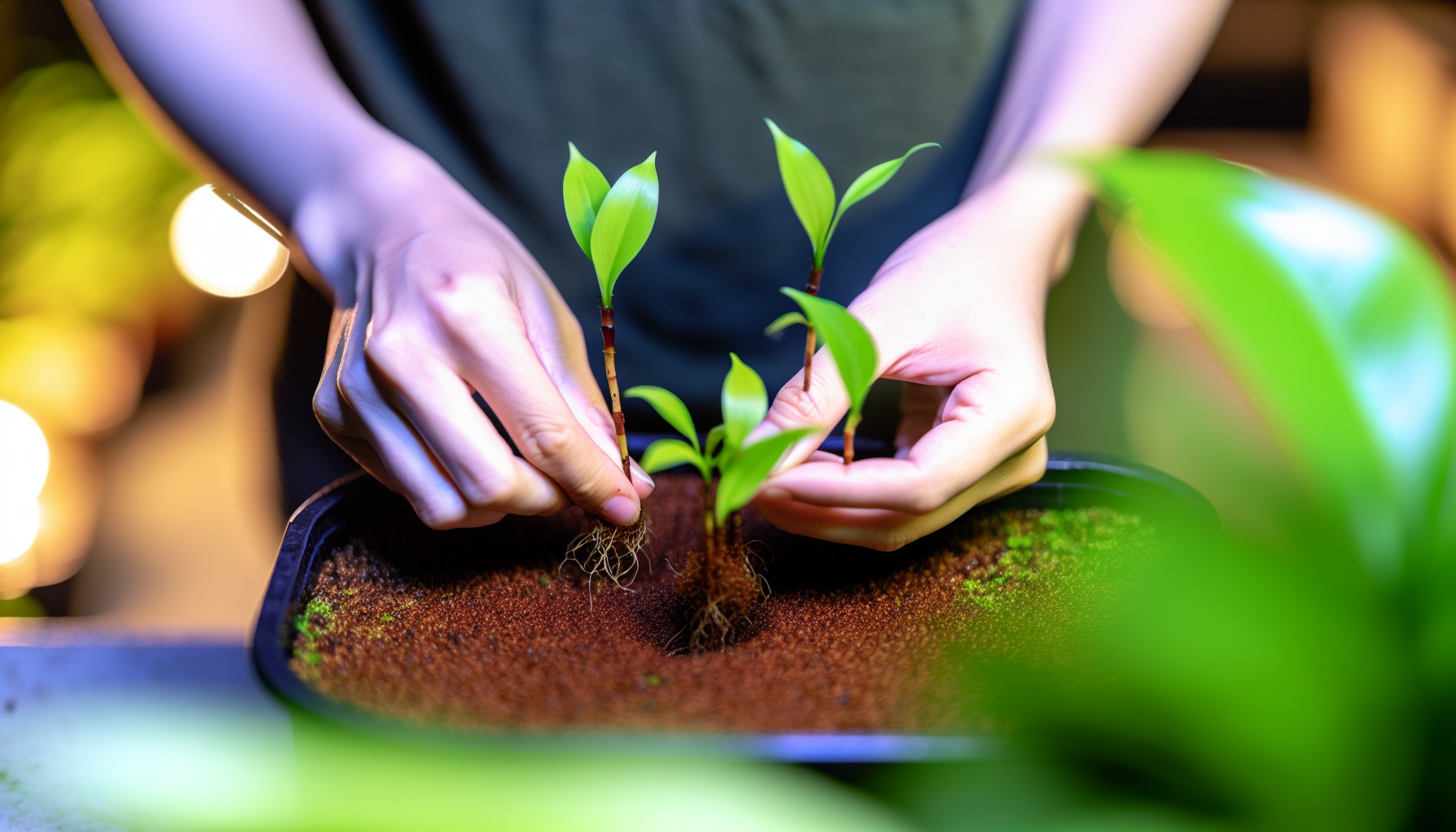
Proper planting and propagation techniques are key to a thriving Alternanthera Reineckii. From cutting the terminal bud and planting it in the substrate to allowing new side shoots to sprout from the remaining stem base, there are several techniques to propagate this beautiful plant.
We will now discuss specific planting tips and spacing, propagation methods, and methods to encourage root development once your plants arrived.
Planting Tips and Spacing
When planting Alternanthera Reineckii, it’s best to:
- Plant it in small groups to create lush clumps
- Use aquascaping tweezers to assist in gentle placement
- Rinse off any gel and keep the roots intact when planting tissue-cultured specimens
- Bear in mind that Alternanthera Reineckii has a slow initial growth phase, which is vital for root development
- Wait up to two weeks for the roots to start forming after planting
Frequent uprooting should be avoided as it disrupts the establishment process and can lead to poor growth conditions. Ensuring a stable environment for Alternanthera Reineckii can promote it as a dependable and flourishing element within the stable community of an aquarium.
Propagation Methods
Alternanthera Reineckii can be propagated like other stem plants by cutting the stem and replanting it. However, it can also be propagated by side stems once they have developed their own root system, followed by separating the daughter stem plant from the mother plant.
During the transition from emersed to submerged growth, Alternanthera Reineckii may melt initially but will eventually root. Floating the stems until they develop aerial roots can aid in replanting. Ultra high Humidity emersed growing can avoid most all melting.
Encouraging Root Development
Encouraging root development in Alternanthera Reineckii can be achieved by acclimating the plant gradually to underwater conditions, which can reduce the risk of root melting during the transition from emersed to submerged growth. A stem cutting with at least four leaves can be either inserted straight into the substrate or floated in water until roots develop to propagate Alternanthera Reineckii and encourage root development.
Trimming long and overgrown roots back to about 1-2 cm after planting in the aquarium can encourage the emergence of new root growth.
Common Issues and Solutions
Every plant has its own set of challenges, and Alternanthera Reineckii is no exception. From algae growth to melting and chlorosis, there are several common issues that you might face while caring for this plant. But don’t worry, with the right strategies and solutions, these problems can be easily managed.
Identifying and Treating Melting
Melting is a common issue with Alternanthera Reineckii. It can occur when the plant is subjected to temperature fluctuations and very low temperatures, as it’s not tolerant of these changes. Melting can also result from stresses like alkaline water conditions and excessive water hardness.
Certain products containing glutaraldehyde can exacerbate melting in Alternanthera Reineckii during an initial adaptation period. However, mitigating meltdown involves improving tank conditions through water changes and cessation of biocide treatments such as glutaraldehyde. Aiding the recovery of Alternanthera Reineckii from melting includes ensuring the provision of essential nutrients and regular removal of damaged leaves.
Preventing Chlorosis
Chlorosis, or the paling of leaves, is another common issue with Alternanthera Reineckii. Adequate lighting is crucial for Alternanthera Reineckii ‘Pink’, as it encourages the leaves to turn red, thus preventing chlorosis.
A deficiency in micronutrients can cause the leaves of Alternanthera Reineckii to turn pale, indicating the onset of chlorosis. By providing the right nutrients and lighting conditions, you can prevent chlorosis and keep your Alternanthera Reineckii looking vibrant and healthy.
Algae Management
Algae growth is a common problem in aquariums and can affect Alternanthera Reineckii as well. To control algae problems in Alternanthera Reineckii aquariums, you can:
- Balance light levels and reduce the photoperiod to prevent excessive light.
- Reduce nutrient dosing and use products to reduce phosphate levels to prevent overfertilization.
- Flush out excess nutrients to control nitrate and phosphate levels and manage algae growth.
Mechanical removal strategies, such as physical removal of algae and boiling water treatment for gravel, can effectively reduce the presence of algae. By taking these steps, you can ensure that your Alternanthera Reineckii thrives in an algae-free environment.
Benefits and Compatibility: Enhancing Your Aquarium
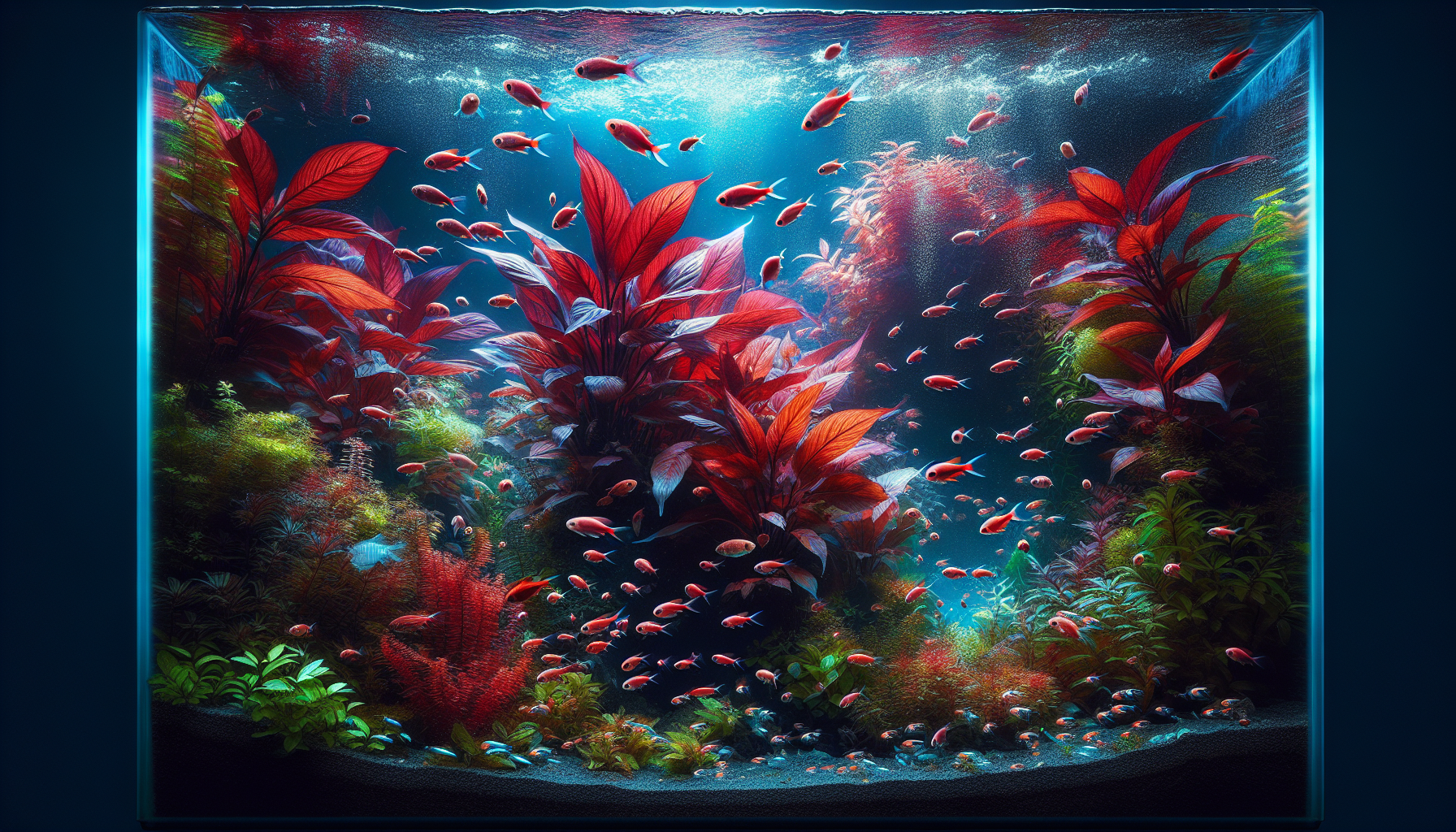
Alternanthera Reineckii is more than just a beautiful aquarium plant. It brings numerous benefits to your aquarium, including:
- Oxygenating the water
- Creating a safe haven for small aquatic creatures
- Adding visual interest and color to your tank
- Helping to maintain water quality by absorbing nitrates and other pollutants
- Providing shelter and hiding places for fish and other inhabitants
It’s also compatible with a variety of aquarium inhabitants, making it a versatile and valuable addition to any tank.
We will now explore in depth these benefits and compatibility.
Aquascaping Advantages
Alternanthera Reineckii can truly enhance the aesthetic appeal of your aquarium. The dense clusters of vibrant red foliage create a visually appealing contrast against green aquatic aquarium plant. Whether you want a plant for the foreground, midground, or background, Alternanthera Reineckii offers aquascaping versatility.
Furthermore, its fast-growing nature (after initial root growing period of roughly 1-2 weeks) allows it to outcompete algae for nutrients, helping maintain an algae-free environment in the aquarium. Since its distribution began in European countries in 2007, Alternanthera Reineckii has seen a rise in popularity as an aquarium plant globally.
Oxygenation and Gas Pocket Prevention
Alternanthera Reineckii doesn’t just look good - it also plays a vital role in oxygenating your aquarium. By performing photosynthesis, it releases oxygen into the water, aiding in the creation of small bubbles known as pearls which further enhance oxygenation of the tank. This oxygen is vital for the respiration of fish and beneficial bacteria, thereby maintaining a balanced and healthy aquarium ecosystem.
In addition, the plant’s well-developed root system aids in disrupting anaerobic pockets in the substrate, preventing the formation of dangerous hydrogen sulfide gas pockets.
Compatible Tank Mates
Alternanthera Reineckii is a great aquarium plant companion for many aquarium inhabitants. It is compatible with:
- Amano shrimp, which can control algae naturally in a tank containing Alternanthera Reineckii without damaging the plant
- Small fry, as its leaf structure provides them with protection from more aggressive fish
- Snails, which are commonly kept in the same tanks and contribute to the health of the aquatic ecosystem
However, care should be taken when keeping shrimp with Alternanthera Reineckii due to the potential harm from high CO2 and copper found in most fertilizers.
Quarantining and Preparing Your Alternanthera Reineckii
Before introducing an aquarium plant like Alternanthera Reineckii into your main tank, it’s important to quarantine and prepare them properly. This is to ensure that the plants are healthy and free of any potential threats such as parasites, pests, and chemicals.
We will now discuss the quarantine process, techniques for cleaning and rinsing, and methods to ensure pest-free plants.
Quarantine Process
Quarantining new aquarium plants like Alternanthera Reineckii is recommended. Here’s how to do it:
- Set up a separate fish-free tank or container.
- Place the new plants in the tank and provide adequate lighting and fertilization.
- Keep the plants in quarantine for at least 5 days to up to 3-4 weeks.
- During this period, perform routine water changes.
- If the quarantine period is reduced to 1 week, opt for daily full water changes.
By following these steps, you can ensure the health and safety of your aquarium.
After each full water change, use a water conditioner like Seachem Prime to neutralize potential pesticides and residues during the shorter, intensive quarantine process.
Cleaning and Rinsing Techniques
Before sterilizing Alternanthera Reineckii, follow these steps:
- Remove any dead or dying leaves and clear away rock wool or sponge-like material from the plant roots to prevent any residue that might harbor pollutants.
- Rinse new plants thoroughly with room temperature water as part of their initial cleaning process.
- After cleaning, sterilize the plants using either a bleach solution dip or hydrogen peroxide treatment to eliminate unwanted microorganisms and pests.
Ensuring Pest-Free Plants
Keeping your Alternanthera Reineckii pest-free is vital for a healthy aquarium. Sterilization methods such as bleach dips, hydrogen peroxide dips, and alum soaks can be effectively used to ensure your plants are free of pests.
Here are the steps for a bleach dip:
- Prepare a solution of 1 part bleach to 20 parts water.
- Dip the plant in the bleach solution for 2-3 minutes.
- Rinse the plant thoroughly in clean water to remove any residual bleach.
- Soak the plant in a dechlorinator solution for 5 minutes to neutralize any remaining bleach.
By following these steps, you can keep your Alternanthera Reineckii pest-free and maintain a healthy aquarium.
A hydrogen peroxide dip can be mixed lightly with 2-3ml per gallon for delicate plants or stronger with a 1:3 ratio of hydrogen peroxide to water for a 20-minute duration. For sensitive plants, an alum soak involves dissolving 1 tablespoon of alum per gallon of water, or only 1-2 teaspoons per gallon, with a soaking period of up to 3 days.
Before quarantine, closely inspect Alternanthera Reineckii for pests by examining both sides of the leaves, stems, and roots. During quarantine, using a water conditioner like Seachem Prime helps to detoxify ammonia, nitrites, nitrates, and removes chlorine and chloramine, further ensuring a pest-free environment for Alternanthera Reineckii.
Tissue Culture Alternatives: Pros and Cons
Tissue culture is an alternative method of cultivating Alternanthera Reineckii that comes with its own set of benefits and potential drawbacks. Tissue cultured plants are grown in sterile labs, ensuring they are free of pests and diseases.
Is tissue culture the right choice for you? We will now examine what tissue culture entails, its benefits, and potential drawbacks.
What is Tissue Culture?
Plant tissue culture is the cultivation of plant cells, tissues, or organs on a sterile nutrient medium under controlled conditions. It’s based on the concept of totipotency, the ability of plant cells to regenerate into a complete plant. Tissue culture involves the use of both organogenesis and embryogenesis, processes that allow the regeneration of new plants from plant cells or tissues.
The nutrient medium typically contains minerals, vitamins, carbohydrates, and growth regulators such as auxins and cytokinins. The culture of plant tissues can be carried out in several forms, including semisolid with a gelling agent like agar, or in liquid cultures such as cell suspensions and bioreactors.
Benefits of Tissue Culture Alternanthera Reineckii
Tissue culture offers several benefits for Alternanthera Reineckii. For one, it ensures that the plants are 100% sterile, free from pests, algae, harmful pesticides, and pathogens, protecting the health of established aquariums. Using tissue cultured Alternanthera Reineckii ‘Mini’ and similar varieties permits a clean start in new aquarium setups, aiding in maintaining a pest-free environment.
Tissue culture cups offer several advantages for aquarium plant enthusiasts:
- They often contain a higher number of plantlets compared to traditional potted or bunched versions, offering better plant quantity for the cost.
- Preparing tissue culture plants for aquariums is efficient; they just need to be rinsed to discard the growth medium.
- They can then be divided into portions for planting.
These advantages make tissue culture cups a popular choice for aquarium plant enthusiasts.
Potential Drawbacks and Considerations
While tissue culture offers numerous benefits, it does come with potential drawbacks. Alternanthera Reineckii is not recommended for beginners due to the need for constant care and conditions that can create complexity for those inexperienced with aquatic plants. It’s prone to iron and potassium deficiencies, evident from pale leaves and pinholes, suggesting elevated care requirements to avoid such issues. It also requires intense lighting and specific water parameters to maintain coloration and health, which might be challenging to achieve consistently.
A plant’s growth can be stunted by allelopathy due to chemicals released by competing plant species, requiring thoughtful plant pairing and placement in the tank.
Summary
In conclusion, the Alternanthera Reineckii is a truly versatile and beautiful addition to any aquarium. Its vibrant coloration, diverse varieties, and aesthetic appeal make it a favorite among aquarium enthusiasts worldwide. Proper care, including the right tank conditions, adequate lighting, nutrient balance, and careful propagation, can ensure this plant thrives. And while it does come with its own set of challenges, with the right strategies and solutions, these can be easily managed. So why wait? Dive into the world of Alternanthera Reineckii and transform your aquarium into a stunning, tranquil underwater haven.
Frequently Asked Questions
Yes, Alternanthera reineckii benefits from CO2 injection for vibrant coloration, but it can still grow in a non-injected tank, albeit with more subdued colors.
To care for Alternanthera Reineckii, ensure it has high nitrates and phosphates, consider using fertilizers like Thrive S Plant Food to promote growth and vibrant coloration. Overall, providing proper nutrients and lighting will help maintain its vibrancy
To propagate Alternanthera Reineckii, you can either cut the stem and replant it or wait for side stems to grow their own root system before separating them. This is the best way to ensure successful propagation.
Some common issues with Alternanthera Reineckii include algae growth, melting, and chlorosis. These problems can be managed with the right strategies and solutions.



 Shrimp
Shrimp Fish
Fish Crab &
Crab & Plants
Plants Foods
Foods Snails
Snails